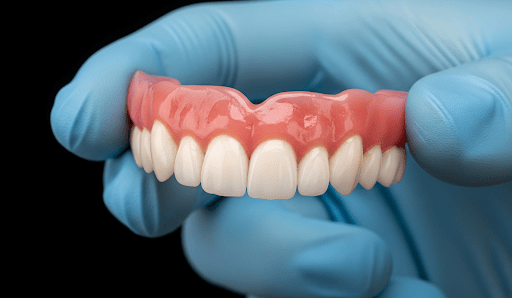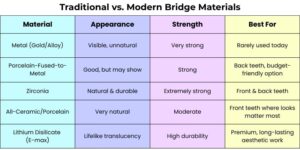A complete smile isn’t just about looks — it’s about confidence, function, and oral health. Missing teeth can make it difficult to chew, speak clearly, and smile freely. For many patients, dental bridges provide the ideal solution to restore both appearance and function. But what makes today’s dental bridges stand out from those in the past?
The answer lies in modern dental materials and technology, which now make bridges look and feel more natural than ever before. Let’s explore how dental bridges work, the role of advanced materials, and what patients can expect from this life-changing treatment.
What Is a Dental Bridge?
A dental bridge is a fixed restoration used to replace one or more missing teeth. It literally “bridges” the gap by anchoring artificial teeth (called pontics) to either natural teeth or dental implants.
Unlike removable dentures, bridges are permanent, stable, and customized to blend seamlessly with your smile. They restore not only the look of your teeth but also your ability to chew and speak with confidence.
Why Dental Bridges Matter
Tooth loss affects more than just your appearance. It can cause:
- Shifting of nearby teeth
- Bite misalignment
- Speech difficulties
- Difficulty chewing certain foods
- Changes in facial structure (sunken cheeks, aged look)
By replacing missing teeth, dental bridges help maintain oral health, restore balance, and prevent long-term complications.
Types of Dental Bridges
Different designs suit different needs. Here are the main types:
- Traditional Bridge – Anchored by crowns on natural teeth on either side of the gap.
- Cantilever Bridge – Supported by a single adjacent tooth, used in special cases.
- Maryland Bridge – Uses a metal or porcelain framework bonded behind natural teeth; often for front teeth.
- Implant-Supported Bridge – Anchored to dental implants instead of natural teeth, providing maximum stability.
How Modern Materials Make Dental Bridges Better
In the past, dental bridges were often made of metal or porcelain fused to metal (PFM). While strong, these options sometimes looked artificial or caused dark lines near the gums.
Today’s dentistry offers advanced materials that combine strength with aesthetics:
- Zirconia – Strong, biocompatible, and tooth-colored. Ideal for back teeth needing durability.
- All-Ceramic/Porcelain – Offers lifelike translucency, perfect for front teeth.
- Porcelain-Fused-to-Zirconia (PFZ) – Combines aesthetics of porcelain with zirconia’s strength.
- Lithium Disilicate (E-max) – Highly aesthetic, durable, and stain-resistant.
Benefits of Modern Dental Bridge Materials
- Natural Appearance – Mimic real tooth color, shine, and translucency.
- Durability – Resistant to chips, cracks, and wear.
- Comfort – Smooth, biocompatible, and easy to adapt to.
- Stain Resistance – Stay bright and fresh over time.
- Custom Fit – Designed with digital impressions and CAD/CAM technology.
The Dental Bridge Procedure: Step by Step
- Consultation & Examination – Dentist evaluates oral health and discusses options.
- Tooth Preparation – Supporting teeth may be shaped to fit crowns (unless implant-supported).
- Digital Impressions – High-tech scans ensure precise fit.
- Temporary Bridge – Protects teeth and maintains appearance while the permanent one is crafted.
- Permanent Bridge Placement – Custom bridge is cemented or fixed in place.
- Final Adjustments – Bite and comfort are checked for a natural feel.
Caring for Dental Bridges
Like natural teeth, bridges require good oral care to last. Here are key tips:
- Brush twice daily with fluoride toothpaste
- Use floss threaders or interdental brushes to clean around the bridge
- Rinse with antibacterial mouthwash
- Avoid biting on hard foods (ice, hard candy)
- Visit your dentist for regular dental checkups and cleanings
With proper care, modern bridges can last 10–15 years or longer.
Common Questions About Dental Bridges
1. Do dental bridges look natural?
Yes — with advanced materials like zirconia and porcelain, bridges blend seamlessly with surrounding teeth.
2. How long do dental bridges last?
With proper care, they typically last 10–15 years, sometimes even longer.
3. Are dental bridges painful to get?
No. Local anesthesia is used, and most patients only experience mild soreness afterward.
4. Can a dental bridge be replaced?
Yes. Old or damaged bridges can be replaced with newer, more aesthetic options.
5. Which is better: a bridge or an implant?
It depends on your oral health, jawbone condition, and budget. Implants offer independence from other teeth, while bridges are quicker and often less costly.
Why Patients Choose Modern Dental Bridges
- A natural-looking smile without obvious dental work
- Restored confidence in speaking and social situations
- Better chewing ability for a varied, healthy diet
- Long-lasting results thanks to modern materials
- A cost-effective solution compared to full implant replacement
Dental bridges have come a long way. Thanks to modern materials like zirconia and lithium disilicate, patients no longer have to choose between strength and appearance — today’s bridges offer both. Whether replacing one tooth or several, dental bridges can give you a natural-looking, functional smile that lasts for years.
If you’ve been considering your options for missing teeth, ask a prosthodontist about the latest advancements in dental bridges. A complete smile may be closer than you think!



